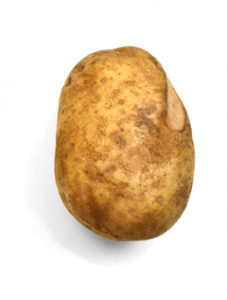1.14: Gramática- Género de sustantivos
- Page ID
- 113858
Objetivos
- Identify the gender of nouns
| ¡OJO! (Watch out!) ¡El género de los sustantivos es importante! | |

el Papa
|

la papa
|
Género de los sustantivos (Gender of Nouns)
All nouns in Spanish have a gender: masculine or feminine. Except in the case of people or animals, linguistic gender is a convention of language, not a property of the noun. For this reason, you won’t be able to guess the gender of a noun based on the object itself; you need to learn the gender along with the noun. However, there are some rules that can help you guess the gender of an unknown word:
1. The gender of nouns:
- The definite article meaning “the” is la for feminine singular nouns.
- Most words ending in –a are feminine
la chica
la silla
la tiza
-
- All words ending in -sión, -ción, -tad, -dad, and –umbre are feminine.
la televisión
la educación
la dificultad
la universidad
la lumbre
- The definite article meaning “the” is el for masculine singular nouns. Notice that el without the accent mark is the article… what does él mean? That’s right, it means “he”. Don’t confuse el and él!
- Most words ending in –o are masculine.
el chico
el libro
el cuaderno
-
- Many but not all words ending in –ma are masculine (the ones that originated from the Greek language are the masculine ones).
el problema
el clima
el idioma
- Many nouns end in –e. While statistically more are masculine than feminine, there is no firm rule for these and you need to memorize their gender when learning their meaning.
la clase
el diente
el coche
- Many nouns that end in consonants other than -d or -z are masculine, but again this is not a firm rule and you must memorize their gender.
el honor
el hospital
el hotel
- There are other nouns that do not clearly reveal their gender, so it is important that you memorize them.
el pupitre
el lápiz
el reloj
la luz
la pared
- There are also some exceptions to the above patterns that you have to remember.
el día
el mapa
la mano
la foto (short for la fotografía)
la moto (short for la motocicleta)
2. People:
- When referring to people, the biological sex of a person will determine a word’s gender regardless of the rules described above. However, as society has become more sensitive to sexism, as well as questions of gender and sexual identity, people have begun experimenting with ways to adjust the traditional binary-gendered structure of the Spanish language. Click here to explore some of the experiments in gender-neutral language that Spanish speakers have been developing.
- Some nouns for people will be identical except for the -o or -a ending.
el muchacho (boy)
la muchacha (girl)
el niño (male child)
la niña (female child)
el maestro (male teacher)
la maestra (female teacher)
el compañero de clase (male classmate)
la compañera de clase (female classmate)
el amigo (male friend)
la amiga (female friend)
- However, other nouns are completely different for masculine and feminine forms.
el hombre (man) la mujer (woman)
- Some nouns for people are identical, and the gender is shown only in the definite article. ¡OJO! A large number of words that identify members of professions or groups end in “-ista” and only distinguish gender by the article; these words end in “-ista” even if masculine.
el estudiante (male student)
la estudiante (female student)
el dentista (male dentist)
la dentista (female dentist)
el optimista (male optimist) la optimista (female optimist)
el anarquista (male anarchist) la anarquista (female anarchist)
Remember! The gender of nouns that do not refer to people is an inherent characteristic that cannot be changed. If you change the gender ending of an inanimate object, you can be changing the meaning of the noun to another legitimate word in Spanish.
- el caso (case) la casa (house)
- el puerto (port) la puerta (door)
- el Papa (the Pope) la papa (potato)
- el libro (book) la libra (pound)
Contributors and Attributions
- El papa Francisco. Authored by: Casa Rosada. Located at: https://es.Wikipedia.org/wiki/Francisco_(papa). License: CC BY-SA: Attribution-ShareAlike
- I love potatoes. Authored by: Joseph Vasquez. Located at: https://www.flickr.com/photos/joe3po/4280126262. License: CC BY: Attribution
- Gramu00e1tica: Gu00e9nero de sustantivos. Authored by: SUNY Oneonta with Lumen Learning. Provided by: SUNY Oneonta. License: CC BY: Attribution


